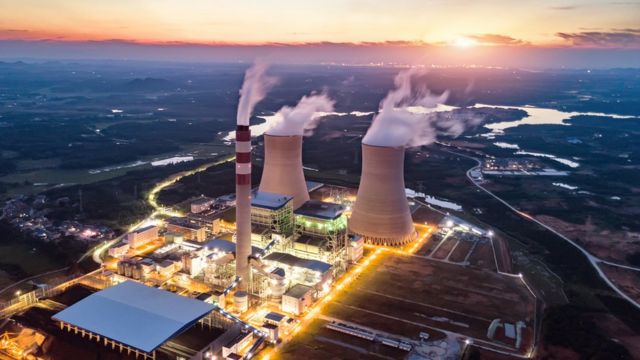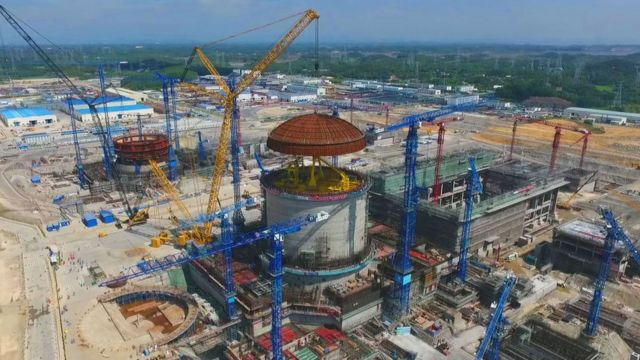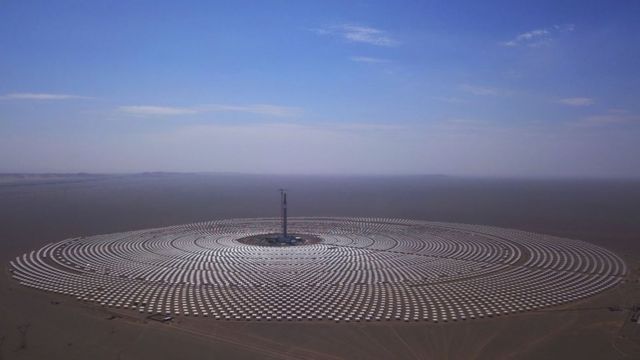The nuclear reactor that could be the 'holy grail' of energy for China
China has about 50 nuclear power plants, but none like the one that will be tested in Wuwéi
The reactor that China is about to test is small, but it has enormous importance for the energy future of the country and the world.
Near the city of Wuwéi (Gansu province, central-north), a nuclear reactor with about three meters high and capacity to generate two megawatts, which is enough to supply about 1,000 homes, will be put into operation.
Generating so little energy doesn't seem like a big deal compared to the hundreds of millions of dollars China has invested in this project.
But it's the kind of nuclear reaction and processing that will be tested that has scientists around the world eager to see their results."The Chinese test is important because it is the first step in rethinking the path of nuclear energy: if things have changed and now there is another direction," he explains to BBC News Mundo, the BBC's Spanish-language news service.
molten salt and thorium
One of the best sources to produce electricity — despite having its image tarnished by accidents like Chernobyl or Fukushima — has been nuclear energy since its invention.
It generates more electricity than others, emits almost no carbon dioxide, guarantees a continuous supply, uses relatively affordable fuels and its residues are much more controllable than from other sources.
Most of the world's nuclear power plants use uranium as fuel.
Thermodynamic plants produce steam, not carbon dioxide
But what is being tested in China is a method that, while not new, has never been tested on such a large scale.
They are using fluoride molten salt combined with thorium, a chemical found in minerals that is "four times" more abundant on the planet than uranium, says Forsberg.
In a reactor, the two elements combine to produce a physical reaction (fission) that generates more heat than the traditional method, which uses uranium-235/238 combined with plutonium.
“Melted salt reactors provide heat at higher temperatures than other reactors, between 600°C and 700°C. Heat at higher temperatures is more valuable,” says Forsberg.
Another advantage, in theory, is that radioactive waste can be disposed of in the same process, preventing it from falling into the wrong hands, such as nuclear weapons manufacturers.
And as this type of process does not require water, as in nuclear plants that use uranium-235, the molten salt reactor can be built in remote locations and thus avoid any possible risk to the population, as we saw in Chernobyl or Fukushima.
All of this has led to it being described as the "Holy Grail" of energy sources.
Thorium is four times more abundant on Earth than uranium
But experts say that all of this has yet to be proven in the Chinese test, which is why it's so important.
"With the critical need to reduce carbon emissions and the world's growing demand for electricity, it is urgent to commercialize advanced reactor technologies," nuclear engineer Everett Redmond, of the US Institute of Nuclear Energy, tells BBC News Mundo.
For Forsberg, "the thorium/uranium-233 fused salt reactor is the alternative path" in the electrical industry that uses a nuclear source.
"There are great potential advantages in terms of safety and waste management, but important technical challenges," says the MIT scientist.
What's next?
China revealed in August that it is about to carry out the first tests on its experimental reactor built in the Gobi Desert in Gansu province.
The Asian country has invested about 3 billion yuan (US$500 million) in a program started in 2011 to investigate the use of molten salt and thorium/uranium-233.
The reactor built and operated by the Shanghai Institute of Applied Physics (IFAS) is the first to test it for a commercial use: supplying electricity.
China has built several power plants, but the one in Gansu province is unique in the world
Other countries had already experimented with this process for decades, but it ended up being only in trials because the technology needed to handle it did not exist.
Not only does it require nuclear fission to work well, it also requires the process for obtaining heat and transporting it to a thermodynamic plant to operate correctly. And that failure tests are controllable.
"Many of the challenges of the molten salt reactor have disappeared due to advances in other fields over 50 years," such as the pumping technology needed for this type of reactor, which is already used in solar plants, explains Forsberg.
IFAS operators now expect everything to go according to plan to take the technology to a greater scale.
Why is it futuristic?
The energy generated by the experimental reactor in Wuwéi will have a minimum capacity of 2 megawatts to supply 1,000 homes.
The plan is that by 2030 a reactor will be built that will generate around 370 megawatts, a capacity that would supply electricity to more than 185,000 homes.
By generating a higher temperature, close to 700 °C, a molten salt reactor becomes more valuable to the electrical industry.
In the same desert as Gansu province, China already has several projects that seek to replace polluting energies
"Heat at a higher temperature results in more efficient energy cycles: a greater fraction of heat is converted into more electricity," explains the MIT scientist.
And as, in theory, its construction has a cost similar to other existing nuclear power plants, the benefit increases.
"If two reactors have identical cost characteristics, the reactor that produces higher temperatures produces a more valuable product," says Forsberg.
China would then guarantee to have the most advanced, safe and cleanest technology for power generation in the world.
Not exclusive, as Redmond explains that in the United States some companies are also trying to create molten salt reactors. But yes, proven.
"All advanced reactor designs have great potential, so we support and encourage the accelerated development, demonstration and commercial deployment of advanced reactor technologies," adds Redmond.
Even so, scientists who are aware of what is happening in China still have their doubts: will it work?
But the simple fact that an idea conceived decades ago is about to be put to the test makes everyone turn to Wuwéi's small reactor.







No comments:
Post a Comment